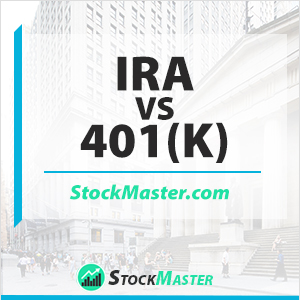 What’s the Difference Between an IRA and 401k?
What’s the Difference Between an IRA and 401k?
Choosing between an IRA vs 401k retirement account can be a difficult decision while you are trying to plan out your retirement.
Preparing for retirement can seem like an overwhelming task. However, that should never be the case with a little bit of planning. What you do while still in the job market, can have a significant impact on the kind of lifestyle you enjoy upon retirement.
Failing to plan for retirement can create a cloud of uncertainty that can lead to an unnecessary level of stress. However, that should never be the case, given an array of retirement plans already in the market. Individual Retirement Account (IRA) and 401k plans are some of the best schemes for saving for retirement.
While IRA and 401K plans offer retirement savings benefits, their contributions and withdrawal rules, vary a great deal. Let’s look at some of the major differences between 401k and IRA accounts to see which one is right for you and your retirement planning.
What Is an IRA?
An Individual Retirement Account (IRA) is a tax-advantaged investing tool that allows people to save for retirement on a tax-deferred basis.
Types of IRA Accounts
Traditional IRA
This is an IRA account that allows people to make retirement contributions with money they may be able to make a deduction on tax returns. Any earnings generated from the account can grow, tax-deferred until one decides to withdraw on retirement.
All inactive U.S taxpayers can contribute to this plan. The maximum annual contribution for 2019 is $6,000. Contributions are tax-deductible up to 100%.
Traditional IRA Pros
- Anyone can contribute
- Tax-sheltered growth
- Tax-deferred growth
- Bankruptcy protection
Traditional IRA Cons
- Taxable Distributions
- Lower contribution limits
- Early withdrawal penalties
- Limited types of investments
Roth IRA
With this type of account, one is allowed to contribute with money already paid taxes on. The money gets to grow tax-free, and one gets to enjoy tax-free withdrawal upon retirement. This is a tax-free vehicle for retirement savings.
To be eligible, one must have earned income not generated from investments or rental property. Individuals above the age of 70 years are eligible.
Roth IRA Pros
- Savings grow tax-free
- No limitations on when one can withdraw money
- Withdrawal is possible in case of death or disability
- There are no mandatory withdrawals
- Heirs of Roth IRA pay no taxes
Roth IRA Cons
- Contributions are not deductible on tax returns
- It comes with income limits that restrict people who can save
- One must set up their own Roth IRA account and remember to fund each year
Rollover IRA
This type of account allows people to contribute with money from qualified retirement plans. One can make contributions from employer-sponsored programs such as 401 (K) and 403 (b)
Rolling over a retirement account can provide one wider investment choices and potentially reduced annual fees and expenses. A rollover also gives rise to the benefit of converting into a Roth IRA to pay income taxes upfront.
Rolling over to an IRA account makes it impossible to get a loan from an employer-sponsored 401(k) account. Withdrawal penalties come into effect upon withdrawing money from A Rollover IRA account prior to attaining 59 ½ years.
What is a 401(k) plan?
401(k) is a retirement savings plan sponsored by an employer. The retirement savings plan allows workers in the U.S to save and invest part of their income before government taxation kicks in.
Types of 401(k) Plans
Traditional 401(k) Plan: Under this plan, employees can contribute part of their income for savings before taxation. One must undergo an annual nondiscrimination tests as a way of ensuring high earners don’t misuse the plan. One must meet the size requirement as well to be eligible.
Safe Harbor 401(k) Plan
Just like Traditional 401(k) one gets to contribute a portion of their wages before taxes. Nondiscrimination tests are not a requirement for the plan. These plans are popular in small businesses settings.
Simple 401(k) Plan
It is similar to Safe Harbor 401(k) as one does not need to perform nondiscrimination tests. However, the plan is only available to small businesses with 100 or fewer employees.
Solo 401(k) Plan
This is a 401(k) plan for businesses that don’t have employees. Unlike the other plans, one does not need to conduct nondiscrimination tests. One cannot have this plan if they have employees.
401(k) Plans Pros
401(k) are advantageous in situations where employers offer the plans and match contributions that their employees make. By doing so, the retirement account value tends to increase exponentially.
401(k) plans are optional. The provision makes it possible to sign up for the plan or choose another retirement savings plan.
401(k) is effective in lowering taxable income. Money saved in 401(k) plans is taken out of the salary before the government taxes it.
401(k) Cons
Withdrawals made before a given period are subject to withdrawal fees.
One must withdraw his or her money ones the age of 70 years is attained.
Being a contribution scheme, there is no guaranteed amount upon retirement. The final payment depends on how investments performed over the years.
How to Choose IRA or 401k Retirement Account
A 401(k) is an employer-sponsored retirement saving plan in which one can make elective deferrals. An IRA, on the other hand, is not tied to an employer and allows one to save depending on the amount of money they make. An IRA account comes with a variety of investment choices that one can use to grow the amount saved
401(K) and IRA are great tax-advantaged ways of saving for retirement. Making a regular contribution to either plan is a sure way of growing investments for retirement. The more contributions one makes, the higher the chances of benefiting from the power of compounding over time.
